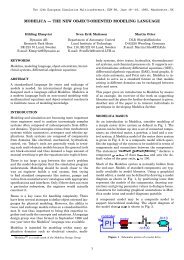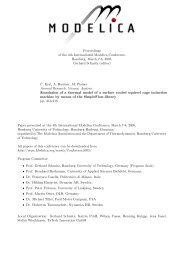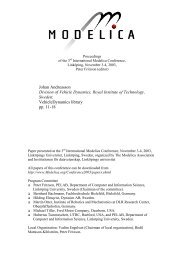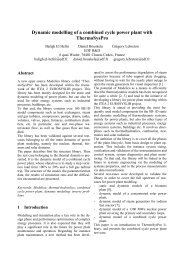Hilding Elmqvist, Hubertus Tummescheit and Martin Otter ... - Modelica
Hilding Elmqvist, Hubertus Tummescheit and Martin Otter ... - Modelica
Hilding Elmqvist, Hubertus Tummescheit and Martin Otter ... - Modelica
Create successful ePaper yourself
Turn your PDF publications into a flip-book with our unique Google optimized e-Paper software.
H. <strong>Elmqvist</strong>, H. <strong>Tummescheit</strong>, M. <strong>Otter</strong> Object-Oriented Modeling of Thermo-Fluid Systems<br />
<strong>and</strong> external heat transfer (for example in a heat<br />
exchanger).<br />
<strong>Modelica</strong> model<br />
The <strong>Modelica</strong> model equations corresponding to the<br />
mass- momentum <strong>and</strong> energy balances derived<br />
above are given below. In addition, a medium<br />
component is used for the mean quantities. The<br />
semiLinear function is used to h<strong>and</strong>le the interfacing<br />
of the balance volume boundary quantities with the<br />
quantities of the device ports as discussed earlier.<br />
model DeviceSegment<br />
replaceable package Medium =<br />
<strong>Modelica</strong>_Media.Interfaces.PartialMedium;<br />
FluidPort port_a (redeclare package<br />
Medium=Medium);<br />
FluidPort port_b (redeclare package<br />
Medium=Medium);<br />
Medium.BaseProperties medium;<br />
// Variable <strong>and</strong> parameter declarations<br />
equation<br />
// Mean values<br />
medium.p =(port_a.p + port_b.p)/2;<br />
m_dot_m = (port_a.m_dot-port_b.m_dot)/2;<br />
d_m = medium.d;<br />
// Mass balance<br />
der(m) = port_a.m_dot + port_b.m_dot;<br />
m = medium.d*A_m*L;<br />
// Substance balances<br />
port_a.mX_dot = semiLinear(port_a.m_dot,<br />
port_a.X, medium.X);<br />
port_b.mX_dot = semiLinear(port_b.m_dot,<br />
port_b.X, medium.X);<br />
der(mX) = port_a.mX_dot + port_b.mX_dot;<br />
mX = m*medium.X;<br />
// Momentum balance<br />
L*der(m_dot_m) =<br />
A_m*(port_a.p - port_b.p)<br />
+ port_a.m_dot*port_a.m_dot/(A_a*d_m)<br />
- port_b.m_dot*port_b.m_dot/(A_b*d_m)<br />
- m_dot_m*abs(m_dot_m)/<br />
(2*d_m*A_m^2)*f*S*L<br />
- A_m*d_m*g*(Z_b - Z_a);<br />
// Energy balance<br />
port_a.H_dot = semiLinear(port_a.m_dot,<br />
port_a.h, medium.h);<br />
port_b.H_dot = semiLinear(port_b.m_dot,<br />
port_b.h, medium.h);<br />
der(U) = port_a.H_dot + port_b.H_dot +<br />
m_dot_m/d_m*(port_b.p - port_a.p) +<br />
heatPort.Q_dot;<br />
U = m*medium.u;<br />
heatPort.T = medium.T;<br />
end DeviceSegment;<br />
The model derivation given above is generic. It can<br />
be generalized <strong>and</strong> extended in many ways. For<br />
example, to allow changing volume of the segment,<br />
the integrations can be carried out with variable<br />
boundaries, using the Leibnitz rule. In the above<br />
derivations, simple definitions of the mean values<br />
were used. It is possible to get better accuracy, for<br />
example, by using an upwind scheme taking into<br />
account the flow direction when calculating the<br />
mean values.<br />
A staggered grid is sometimes used for<br />
solving such PDEs. It is claimed to give better<br />
convergence properties in certain cases by a better<br />
approximation of the pressure gradient. It is possible<br />
to make such an implementation in <strong>Modelica</strong>. In<br />
fact, the ThermoFluid library uses the staggered grid<br />
approach. In this case, the equation for momentum<br />
⎡ L L⎤<br />
is integrated over another interval a− , a+<br />
⎢⎣ 2 2⎥⎦<br />
.<br />
This momentum can be included in a flow element<br />
model. The mass <strong>and</strong> energy balances are included<br />
in a finite volume model. There are special problems<br />
of communicating, for example, the momentum<br />
2 2<br />
term ρvA − ρvA<br />
since the flow<br />
x= a+ L/2 x= a−L/2 element is assumed to have the same mass flow rate<br />
at both its connectors. Additional, non-physical,<br />
connectors or additional connector variables need to<br />
be introduced in order to communicate these<br />
variables to neighboring flow elements.<br />
4 Pressure Loss due to Friction<br />
The momentum balance contains a term for the<br />
friction force<br />
1 1<br />
Ffric = m&<br />
m m&<br />
m fmS<br />
mL<br />
2<br />
2 ρ A<br />
m m<br />
Often, the pressure loss is used instead of the<br />
friction force (pLoss = Ffric/Am) <strong>and</strong> different<br />
equations are in use to compute the pressure loss<br />
from the mass flow rate. In the <strong>Modelica</strong>_Fluid<br />
library a component to model this pressure loss is<br />
available that provides two versions of a generic<br />
pressure loss equation:<br />
if from_dp then<br />
m&<br />
m = f1(<br />
pLoss<br />
,...)<br />
else<br />
pLoss<br />
= f2<br />
( m&<br />
m,...)<br />
end if<br />
Using the parameter “from_dp” in the “Advanced”-<br />
menu, users can select whether the mass flow rate is<br />
computed from the pressure loss (this is the default)<br />
or whether the pressure loss is computed from the<br />
mass flow rate. Depending on how the device is<br />
connected in a network, there might be fewer nonlinear<br />
equations if parameter “from_dp” is selected<br />
The <strong>Modelica</strong> Association <strong>Modelica</strong> 2003, November 3-4, 2003

















